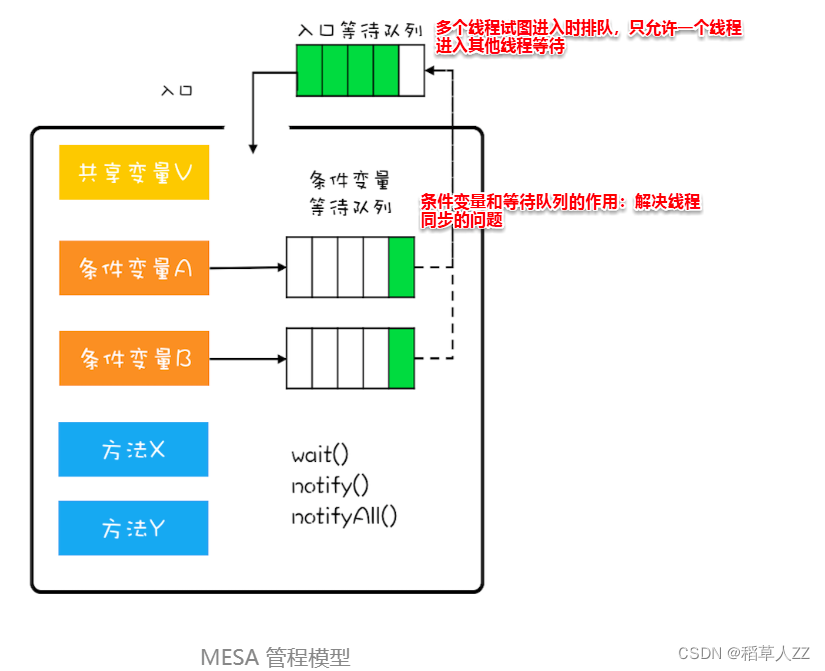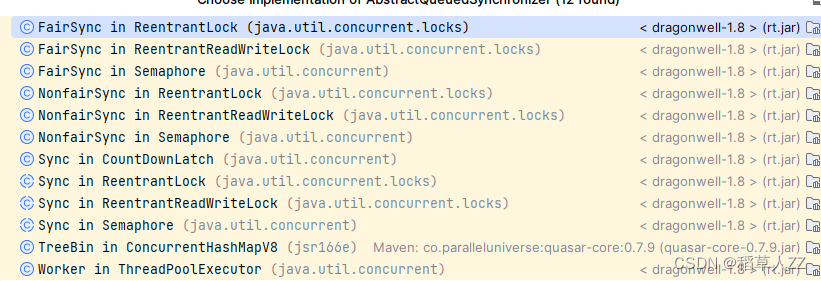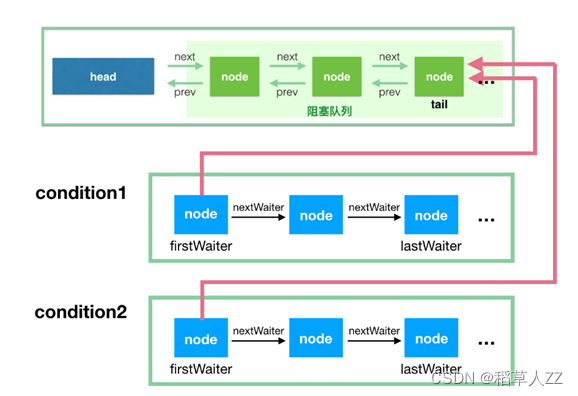JUC并发工具类--AQS
管程 — Java同步的设计思想
管程:指的是管理共享变量以及对共享变量的操作过程,让他们支持并发。
互斥:同一时刻只允许一个线程访问共享资源;
同步:线程之间如何通信、协作。
MESA模型
在管程的发展史上,先后出现过三种不同的管程模型,分别是Hasen模型、Hoare模型和MESA模型。现在正在广泛使用的是MESA模型。

管程中引入了条件变量的概念,而且每个条件变量都对应有一个等待队列。条件变量和等待队列的作用是解决线程之间的同步问题。
Java中针对管程有两种实现:
- 一种是基于Object的Monitor机制,用于synchronized内置锁的实现
- 一种是抽象队列同步器AQS,用于JUC包下Lock锁机制的实现
AQS(AbstractQueuedSynchronizer:抽象队列同步器)
AQS简介
java.util.concurrent包中的大多数同步器实现都是围绕着共同的基础行为,比如等待队列、条件队列、独占获取、共享获取等,而这些行为的抽象就是基于AbstractQueuedSynchronizer(简称AQS)实现的,AQS是一个抽象同步框架,可以用来实现一个依赖状态的同步器。
JDK中提供的大多数的同步器如Lock, Latch, Barrier等,都是基于AQS框架来实现的。
- 一般是通过一个内部类Sync继承 AQS
- 将同步器所有调用都映射到Sync对应的方法

AQS具备的特性:
- 阻塞等待队列
- 共享/独占
- 公平/非公平
- 可重入
- 允许中断
AQS核心结构
AQS内部维护属性state。
state表示资源的可用状态。
/**
* The synchronization state.
*/
private volatile int state;
state三种访问方式
/**
* Returns the current value of synchronization state.
* This operation has memory semantics of a {@code volatile} read.
* @return current state value
*/
protected final int getState() {
return state;
}
/**
* Sets the value of synchronization state.
* This operation has memory semantics of a {@code volatile} write.
* @param newState the new state value
*/
protected final void setState(int newState) {
state = newState;
}
/**
* Atomically sets synchronization state to the given updated
* value if the current state value equals the expected value.
* This operation has memory semantics of a {@code volatile} read
* and write.
*
* @param expect the expected value
* @param update the new value
* @return {@code true} if successful. False return indicates that the actual
* value was not equal to the expected value.
*/
protected final boolean compareAndSetState(int expect, int update) {
// See below for intrinsics setup to support this
return unsafe.compareAndSwapInt(this, stateOffset, expect, update);
}
两种资源访问方式
- Exclusive-独占,只有一个线程能执行,如ReentrantLock
- Share-共享,多个线程可以同时执行,如Semaphore/CountDownLatch
AQS实现时主要实现的方法
isHeldExclusively()
该线程是否正在独占资源。只有用到condition才需要去实现它。
tryAcquire(int)
独占方式。尝试获取资源,成功则返回true,失败则返回false。
tryRelease(int)
独占方式。尝试释放资源,成功则返回true,失败则返回false。
tryAcquireShared(int)
共享方式。尝试获取资源。负数表示失败;0表示成功,但没有剩余可用资源;正数表示成功,且有剩余资源。
tryReleaseShared(int)
共享方式。尝试释放资源,如果释放后允许唤醒后续等待结点返回true,否则返回false。

AQS定义的两种队列
AQS 队列中5个节点状态(waitStatus):
- 值为0,初始化状态,表示当前节点在sync队列中,等待着获取锁。
- CANCELLED,值为1,表示当前的线程被取消;
- SIGNAL,值为-1,表示当前节点的后继节点包含的线程需要运行,也就是unpark;
- CONDITION,值为-2,表示当前节点在等待condition,也就是在condition队列中;
- PROPAGATE,值为-3,表示当前场景下后续的acquireShared能够得以执行;
/** waitStatus value to indicate thread has cancelled */
static final int CANCELLED = 1;
/** waitStatus value to indicate successor's thread needs unparking */
static final int SIGNAL = -1;
/** waitStatus value to indicate thread is waiting on condition */
static final int CONDITION = -2;
/**
* waitStatus value to indicate the next acquireShared should
* unconditionally propagate
*/
static final int PROPAGATE = -3;
/**
* Status field, taking on only the values:
* SIGNAL: The successor of this node is (or will soon be)
* blocked (via park), so the current node must
* unpark its successor when it releases or
* cancels. To avoid races, acquire methods must
* first indicate they need a signal,
* then retry the atomic acquire, and then,
* on failure, block.
* CANCELLED: This node is cancelled due to timeout or interrupt.
* Nodes never leave this state. In particular,
* a thread with cancelled node never again blocks.
* CONDITION: This node is currently on a condition queue.
* It will not be used as a sync queue node
* until transferred, at which time the status
* will be set to 0. (Use of this value here has
* nothing to do with the other uses of the
* field, but simplifies mechanics.)
* PROPAGATE: A releaseShared should be propagated to other
* nodes. This is set (for head node only) in
* doReleaseShared to ensure propagation
* continues, even if other operations have
* since intervened.
* 0: None of the above
*
* The values are arranged numerically to simplify use.
* Non-negative values mean that a node doesn't need to
* signal. So, most code doesn't need to check for particular
* values, just for sign.
*
* The field is initialized to 0 for normal sync nodes, and
* CONDITION for condition nodes. It is modified using CAS
* (or when possible, unconditional volatile writes).
*/
volatile int waitStatus;
同步等待队列
用于维护获取锁失败时入队的线程。
AQS当中的同步等待队列也称CLH队列(Craig、Landin、Hagersten三人发明的),是一种基于双向链表数据结构的队列,是FIFO先进先出线程等待队列,Java中的CLH队列是原CLH队列的一个变种,线程由原自旋机制改为阻塞机制。
AQS 依赖CLH同步队列来完成同步状态的管理:
- 当前线程如果获取同步状态失败时,AQS则会将当前线程已经等待状态等信息构造成一个节点(Node)并将其加入到CLH同步队列,同时会阻塞当前线程。
- 当同步状态释放时,会把首节点唤醒(公平锁),使其再次尝试获取同步状态。
- 通过signal或signalAll将条件队列中的节点转移到同步队列。(由条件队列转化为同步队列)

条件等待队列
调用await()的时候会释放锁,然后线程会加入到条件队列,调用signal()唤醒的时候会把条件队列中的线程节点移动到同步队列中,等待再次获得锁。
AQS中条件队列是使用单向列表保存的,用nextWaiter来连接:
- 调用await()方法阻塞线程;
- 当前线程存在于同步队列的头结点,调用await()方法进行阻塞(从同步队列转化到条件队列)





















 473
473











 被折叠的 条评论
为什么被折叠?
被折叠的 条评论
为什么被折叠?








